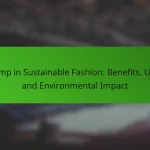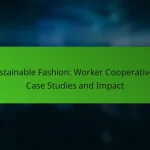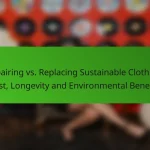What are the current trends in sustainable fashion?
Current trends in sustainable fashion emphasize eco-friendly practices, ethical production, and transparency in the supply chain. These trends reflect a growing consumer demand for clothing that minimizes environmental impact and promotes social responsibility.
Rise of circular fashion
Circular fashion focuses on designing products with their entire lifecycle in mind, aiming to reduce waste and promote reuse. This approach encourages brands to create garments that can be repaired, recycled, or upcycled, thus extending their lifespan and reducing landfill contributions.
Many companies are adopting take-back programs, where consumers can return old items for recycling or refurbishment. This not only fosters customer loyalty but also helps brands manage their environmental footprint effectively.
Increased use of organic materials
The use of organic materials in fashion is on the rise, driven by consumer awareness of the environmental impacts of conventional farming. Organic cotton, hemp, and linen are becoming popular choices as they require fewer chemicals and water compared to traditional fibers.
Brands are increasingly sourcing materials certified by organizations like the Global Organic Textile Standard (GOTS), ensuring that their products meet strict environmental and social criteria. This shift not only benefits the planet but also appeals to eco-conscious consumers.
Growth of ethical brands
Ethical brands are gaining traction as consumers seek transparency in labor practices and fair wages. These brands prioritize ethical sourcing and manufacturing, often providing detailed information about their supply chains.
Many ethical fashion labels are committed to fair trade practices, ensuring that workers receive fair compensation and work in safe conditions. This commitment resonates with consumers who value social responsibility alongside sustainability.
Focus on transparency
Transparency in the fashion industry is becoming a critical demand from consumers, who want to know where and how their clothing is made. Brands are responding by sharing information about their sourcing, production processes, and labor practices.
Some companies are utilizing technology, such as blockchain, to provide verifiable information about their supply chains. This level of transparency builds trust and encourages consumers to make informed purchasing decisions.
Technological innovations
Technological advancements are playing a significant role in promoting sustainable fashion. Innovations such as 3D printing and digital design reduce waste by allowing for precise production and customization.
Additionally, developments in fabric recycling technologies enable the transformation of post-consumer waste into new textiles, further supporting the circular fashion model. These technologies not only enhance sustainability but also offer brands new ways to engage with consumers creatively.
How are major brands adopting sustainable practices?
Major brands are increasingly integrating sustainable practices into their operations by focusing on eco-friendly materials, ethical production methods, and waste reduction strategies. These initiatives not only enhance brand reputation but also cater to a growing consumer demand for responsible fashion choices.
Patagonia’s commitment to recycling
Patagonia has long been a leader in sustainable fashion, emphasizing recycling as a core principle. The brand encourages customers to return used items through its Worn Wear program, which repairs and resells pre-owned gear, thus extending the lifecycle of products.
Additionally, Patagonia uses recycled materials in many of its products, such as polyester made from plastic bottles. This commitment reduces reliance on virgin resources and minimizes environmental impact.
H&M’s Conscious Collection
H&M’s Conscious Collection showcases the brand’s effort to incorporate sustainable materials like organic cotton and recycled polyester. This line aims to offer stylish options while promoting environmental responsibility.
The collection is part of H&M’s broader sustainability strategy, which includes a goal to use only recycled or sustainably sourced materials by 2030. Shoppers can identify these items by the Conscious label, making it easier to choose eco-friendly options.
Nike’s Move to Zero initiative
Nike’s Move to Zero initiative is a comprehensive approach to achieving zero waste and zero carbon emissions. The program focuses on sustainable design, innovative materials, and efficient manufacturing processes to minimize environmental impact.
Key components of this initiative include the use of recycled materials in products and the implementation of renewable energy in production facilities. Nike aims to inspire consumers to join in sustainability efforts by promoting awareness and encouraging responsible consumption.
What are the benefits of sustainable fashion?
Sustainable fashion offers numerous benefits, including environmental conservation, ethical labor practices, and improved consumer health. By prioritizing eco-friendly materials and fair production methods, sustainable fashion helps reduce negative impacts on the planet and promotes social responsibility.
Environmental impact reduction
Sustainable fashion significantly reduces environmental impact by minimizing waste and pollution. Brands often use organic materials, recycled fabrics, and eco-friendly dyes, which lower carbon footprints and conserve water. For example, organic cotton uses up to 90% less water compared to conventional cotton.
Additionally, sustainable practices include producing clothing in smaller batches to reduce overproduction and waste. Consumers can also contribute by choosing high-quality, timeless pieces that last longer, thus decreasing the frequency of purchases.
Support for fair labor practices
Supporting sustainable fashion often means endorsing brands that prioritize fair labor practices. These companies typically ensure safe working conditions, fair wages, and reasonable hours for their workers. This contrasts with fast fashion, which frequently exploits labor in developing countries.
By choosing sustainable brands, consumers help promote ethical treatment of workers. Look for certifications such as Fair Trade or GOTS (Global Organic Textile Standard) to identify companies committed to fair labor practices.
Consumer health benefits
Sustainable fashion can also lead to improved consumer health by using non-toxic materials and dyes. Many conventional clothing items contain harmful chemicals that can irritate the skin or cause long-term health issues. Sustainable brands often avoid these substances, opting for natural alternatives instead.
Moreover, investing in sustainable fashion means purchasing higher-quality garments that are less likely to wear out quickly. This not only benefits the environment but also ensures that consumers are not exposed to harmful chemicals over time.
What challenges does the sustainable fashion industry face?
The sustainable fashion industry faces several significant challenges that hinder its growth and effectiveness. Key issues include high production costs, a lack of consumer awareness and education, and complex supply chain dynamics.
High production costs
High production costs are a primary barrier for sustainable fashion brands. Eco-friendly materials and ethical manufacturing processes often come with a premium price tag, making it difficult for brands to compete with fast fashion retailers. For instance, organic cotton can cost up to 20% more than conventional cotton.
Brands must balance quality and sustainability while keeping prices accessible for consumers. This often leads to higher retail prices, which can deter price-sensitive shoppers. To mitigate costs, brands can explore partnerships with local suppliers or invest in technology that enhances production efficiency.
Consumer awareness and education
Consumer awareness and education play a crucial role in the adoption of sustainable fashion. Many shoppers are unaware of the environmental and social impacts of their clothing choices, leading to a preference for cheaper, less sustainable options. Brands need to invest in marketing strategies that highlight the benefits of sustainable products.
Engaging storytelling, transparent sourcing practices, and educational campaigns can help inform consumers about the value of sustainability. Collaborations with influencers and sustainability advocates can also amplify these messages and reach a broader audience.
Supply chain complexities
Supply chain complexities pose significant challenges for sustainable fashion brands. The journey from raw materials to finished products often involves multiple stakeholders, making it difficult to ensure ethical practices at every stage. Brands must navigate issues like sourcing sustainable materials, ensuring fair labor practices, and minimizing carbon footprints.
To address these complexities, brands can adopt technologies like blockchain for greater transparency and traceability. Establishing strong relationships with suppliers and conducting regular audits can also help maintain ethical standards throughout the supply chain.
How can consumers participate in sustainable fashion?
Consumers can actively participate in sustainable fashion by making conscious choices that reduce waste and promote ethical practices. This includes opting for second-hand clothing, supporting eco-friendly brands, and being mindful of their purchasing habits.
Choosing second-hand clothing
Choosing second-hand clothing is a practical way to engage in sustainable fashion. By purchasing pre-owned garments, consumers help reduce the demand for new production, which often involves significant environmental impact.
When shopping for second-hand items, consider exploring thrift stores, online resale platforms, and local swap events. These options often offer a wide variety of styles at lower prices, making it easier to find unique pieces while saving money.
Be mindful of the condition of the clothing you select. Look for items that are gently used and can be easily cleaned or repaired. This approach not only extends the life of the garments but also minimizes waste in landfills.







